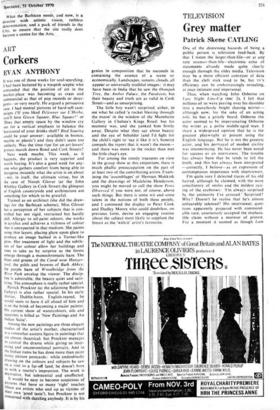ART
Corkers
EVAN ANTHONY
It was one of those weeks for soul-searching. I had been lectured by a waspish sceptic who contended that the position of art in the market-place was becoming as crass and commercial as that of pop records or deter- gents—or very nearly. He argued a persuasive case. I had mental pictures of hard-sell cam- paigns ('If you liked Dejeuner sur L'Herbe, you'll love Green Square. Blue Square!' or `Does that empty space by the window cry out for a vertical emphasis to balance the horizontal of your drinks shelf? Bird Soaring could be your answer: available in bronze, marble or plastic') and they didn't seem too unlikely. Was the time ripe for an art-lovers' protest march down Bond and Cork Streets?
Next week maybe. This week, as it happens, the product is very superior and worth buying. It's also a good week for any- one who gathers comfort from being able to recognise instantly what the artist is on about —not, in itself, the ultimate virtue, but in the case of Norah Glover (at the John Whibley Gallery in Cork Street) the glimpses of English countryside and architecture are something for which to be grateful.
Trained as an architect (she did the draw- ings for the Barbican scheme), Miss Glover has a perception of her subjects that is con- trolled but not rigid, restrained but hardly dull. Allergic to oil-paint odours, she works in acrylics and achieves a richness of colour that is unexpected in that medium. She paints using thin layers, placing glaze upon glaze to produce an image bathed in a Turner-like glow. Her treatment of light and the subtle- ties of her colour allow her buildings and trees to take us by surprise as the forms emerge through a monochromatic haze. The blues and greens of the Canal near Hunger-_ ford, the golds and browns of Bath Abbey. the purple haze of Woodbridge from the River Path envelop the viewer. The discip- line is admirable, the beauty quiet and satis- fying. The atmosphere is really rather special.
Patrick Procktor (at the adjoining Redfern Gallery) is also rather special. In his early thirties, Dublin-born, English-reared, he would seem to have it all ahead of him and k on the brink of becoming a major painter. His current show of watercolours, oils and aquatints is billed as 'New Paintings and An Indian Suite'.
Among the new paintings are three elegant studies of the artist's mother, characterised as a somewhat austere figure in paintings that are almost theatrical; but Procktor manages to control the drama while giving us inter- esting and unconventional portraits. And in the Indian items he has done more than paint exotic picture postcards: while undoubtedly drawing on the colours and subjects he saw on a visit to a far-off land, he doesn't bore us with a tourist's impression. The work is decorative. but substantial and unaffected. It would be easy to become suspicious of pictures that have so many 'right' touches (there are artists who end up as victims of their own 'good taste), but Procktor is not concerned with dazzling anybody. It is by his genius in composition that he succeeds in containing the essence of a scene so economically. Landscapes, sunsets, clouds, all appear as universally truthful images: it may have been in India that he saw the Oompah Tree, the Amber Palace, the Parakeets, but their beauty and truth are as valid in Cork Street—and as unsurprising.
The little boy wasn't surprised, either, to see what he called 'a rocket blasting through the moon' in the window of the Mannheim Gallery in Chelsea's Kings Road; but his mummy was, and she yanked him firmly away. Despite what they say about beauty and the eye of beholder (and I'd fight for the child's right to 'say it like it is'), honesty compels the report that it wasn't the moon— and there was more to the rocket than met the little chap's eye.
For among the trendy treasures on view in the group show at this emporium, there is much phallic preoccupation on the part of at least two of the contributing artists. Exam- ining the 'assemblages' of Herman Makkink and the drawings of Madeleine Henderson, you might be moved to call the show Penis Observed if you were not, of course, above such things. But there is some wit and some talent in the notions of both these people, and I commend the display to Peter Cook and Dudley Moore who could doubtless, on previous form, devise an engaging routine about the subject most likely to supplant the breast as the 'with-it' artist's favourite.










































 Previous page
Previous page